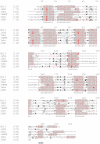Structure-function relationship of cytoplasmic and nuclear IκB proteins: an in silico analysis
- PMID: 21203422
- PMCID: PMC3009747
- DOI: 10.1371/journal.pone.0015782
Structure-function relationship of cytoplasmic and nuclear IκB proteins: an in silico analysis
Abstract
Cytoplasmic IκB proteins are primary regulators that interact with NF-κB subunits in the cytoplasm of unstimulated cells. Upon stimulation, these IκB proteins are rapidly degraded, thus allowing NF-κB to translocate into the nucleus and activate the transcription of genes encoding various immune mediators. Subsequent to translocation, nuclear IκB proteins play an important role in the regulation of NF-κB transcriptional activity by acting either as activators or inhibitors. To date, molecular basis for the binding of IκBα, IκBβ and IκBζ along with their partners is known; however, the activation and inhibition mechanism of the remaining IκB (IκBNS, IκBε and Bcl-3) proteins remains elusive. Moreover, even though IκB proteins are structurally similar, it is difficult to determine the exact specificities of IκB proteins towards their respective binding partners. The three-dimensional structures of IκBNS, IκBζ and IκBε were modeled. Subsequently, we used an explicit solvent method to perform detailed molecular dynamic simulations of these proteins along with their known crystal structures (IκBα, IκBβ and Bcl-3) in order to investigate the flexibility of the ankyrin repeat domains (ARDs). Furthermore, the refined models of IκBNS, IκBε and Bcl-3 were used for multiple protein-protein docking studies for the identification of IκBNS-p50/p50, IκBε-p50/p65 and Bcl-3-p50/p50 complexes in order to study the structural basis of their activation and inhibition. The docking experiments revealed that IκBε masked the nuclear localization signal (NLS) of the p50/p65 subunits, thereby preventing its translocation into the nucleus. For the Bcl-3- and IκBNS-p50/p50 complexes, the results show that Bcl-3 mediated transcription through its transactivation domain (TAD) while IκBNS inhibited transcription due to its lack of a TAD, which is consistent with biochemical studies. Additionally, the numbers of identified flexible residues were equal in number among all IκB proteins, although they were not conserved. This could be the primary reason for their binding partner specificities.
Conflict of interest statement
Figures









Similar articles
-
The Nuclear Protein IκBζ Forms a Transcriptionally Active Complex with Nuclear Factor-κB (NF-κB) p50 and the Lcn2 Promoter via the N- and C-terminal Ankyrin Repeat Motifs.J Biol Chem. 2016 Sep 23;291(39):20739-52. doi: 10.1074/jbc.M116.719302. Epub 2016 Aug 3. J Biol Chem. 2016. PMID: 27489104 Free PMC article.
-
Molecular modeling-based evaluation of dual function of IκBζ ankyrin repeat domain in toll-like receptor signaling.J Mol Recognit. 2011 Jul-Aug;24(4):597-607. doi: 10.1002/jmr.1085. Epub 2010 Nov 26. J Mol Recognit. 2011. PMID: 21472811
-
Characterization of the nuclear import and export functions of Ikappa B(epsilon).J Biol Chem. 2002 Jun 28;277(26):23358-66. doi: 10.1074/jbc.M111559200. Epub 2002 Apr 22. J Biol Chem. 2002. PMID: 11970947
-
Role of nuclear IkappaB proteins in the regulation of host immune responses.J Infect Chemother. 2008 Aug;14(4):265-9. doi: 10.1007/s10156-008-0619-y. Epub 2008 Aug 17. J Infect Chemother. 2008. PMID: 18709529 Review.
-
Regulation and Function of the Atypical IκBs-Bcl-3, IκBNS, and IκBζ-in Lymphocytes and Autoimmunity.Eur J Immunol. 2025 May;55(5):e202451273. doi: 10.1002/eji.202451273. Eur J Immunol. 2025. PMID: 40359334 Free PMC article. Review.
Cited by
-
iBCE-EL: A New Ensemble Learning Framework for Improved Linear B-Cell Epitope Prediction.Front Immunol. 2018 Jul 27;9:1695. doi: 10.3389/fimmu.2018.01695. eCollection 2018. Front Immunol. 2018. PMID: 30100904 Free PMC article.
-
PVP-SVM: Sequence-Based Prediction of Phage Virion Proteins Using a Support Vector Machine.Front Microbiol. 2018 Mar 16;9:476. doi: 10.3389/fmicb.2018.00476. eCollection 2018. Front Microbiol. 2018. PMID: 29616000 Free PMC article.
-
NFκB-inducing kinase inhibits NFκB activity specifically in neurons of the CNS.J Neurochem. 2016 Apr;137(2):154-63. doi: 10.1111/jnc.13526. Epub 2016 Mar 15. J Neurochem. 2016. PMID: 26778773 Free PMC article.
-
Mapping the Interaction of B Cell Leukemia 3 (BCL-3) and Nuclear Factor κB (NF-κB) p50 Identifies a BCL-3-mimetic Anti-inflammatory Peptide.J Biol Chem. 2015 Jun 19;290(25):15687-15696. doi: 10.1074/jbc.M115.643700. Epub 2015 Apr 28. J Biol Chem. 2015. PMID: 25922067 Free PMC article.
-
Caspase Recruitment Domain-Containing Protein 9 Expression is a Novel Prognostic Factor for Lung Adenocarcinoma.Onco Targets Ther. 2020 Sep 10;13:9005-9013. doi: 10.2147/OTT.S265539. eCollection 2020. Onco Targets Ther. 2020. PMID: 32982291 Free PMC article.
References
-
- Hoffmann A, Baltimore D. Circuitry of nuclear factor kappaB signaling. Immunol Rev. 2006;210:171–186. - PubMed
-
- Ghosh S, Hayden MS. New regulators of NF-kappaB in inflammation. Nat Rev Immunol. 2008;8:837–848. - PubMed
-
- Hayden MS, Ghosh S. Shared principles in NF-kappaB signaling. Cell. 2008;132:344–362. - PubMed
-
- Yamamoto M, Takeda K. Role of nuclear IkappaB proteins in the regulation of host immune responses. J Infect Chemother. 2008;14:265–269. - PubMed
Publication types
MeSH terms
Substances
LinkOut - more resources
Full Text Sources
Research Materials

